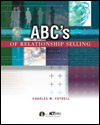Charles M. Futrell,
Texas A&M University
| advantage | The performance characteristic of a product that describes how it can be used or will help the buyer.
(See 68)
|
 |
 |
 |
| attitudes | A person's learned predispositions toward something.
(See 78)
|
 |
 |
 |
| belief | A state of mind in which trust or confidence is placed in something or someone.
(See 78)
|
 |
 |
 |
| benefit | A favorable result the buyer receives from the product because of a particular advantage that has the ability to satisfy a buyer's need.
(See 68)
|
 |
 |
 |
| benefit selling | A method of selling by which a salesperson relates a product's benefits to the consumer's needs using the product's features and advantages as support.
(See 67)
|
 |
 |
 |
| black box | The unobservable, internal process taking place within the mind of the prospect as he or she reaches a decision whether or not to buy.
(See 65)
|
 |
 |
 |
| collect information | The process by which buyers visit retail stores, contact potential suppliers, or talk with salespeople about a product's price, size, advantage, and warranty before making a decision regarding buying.
(See 86)
|
 |
 |
 |
| conscious need level | A state of mind in which buyers are fully aware of their needs.
(See 67)
|
 |
 |
 |
| economic needs | The buyer's need to purchase the most satisfying product for the money.
(See 66)
|
 |
 |
 |
| extensive decision making | Decision-making characteristic of buyers who are unfamiliar with a specific product and who must therefore become highly involved in the decision-making process.
(See 84)
|
 |
 |
 |
| FAB selling technique | A presentation technique stressing the features, advantages, and benefits of a product.
(See 68)
|
 |
 |
 |
| feature | Any physical characteristic of a product.
(See 68)
|
 |
 |
 |
| ideal self | The person one would like to be.
(See 79)
|
 |
 |
 |
| information evaluation | A process that determines what will be purchased as the buyer matches this information with needs, attitudes, and beliefs in making a decision.
(See 86)
|
 |
 |
 |
| learning | Acquiring knowledge or behavior based on past experiences.
(See 77)
|
 |
 |
 |
| limited decision making | Decision-making characteristics of a buyer who invests a moderate level of energy in the decision to buy because, although the buyer is not familiar with each brand's features, advantages, and benefits, the general quality of the good is known to him or her.
(See 83)
|
 |
 |
 |
| L-O-C-A-T-E | An acronym for methods to uncover important needs: listen, observe, combine, ask questions, talk to others, empathize.
(See 71)
|
 |
 |
 |
| looking-glass self | The self that people think other people see them as.
(See 79)
|
 |
 |
 |
| need arousal | A situation in which a salesperson triggers a psychological, social, or economic need in the buyer.
(See 85)
|
 |
 |
 |
| needs | The desire for something a person feels is worthwhile.
(See 66)
|
 |
 |
 |
| perception | The process by which a person selects, organizes, and interprets information.
(See 76)
|
 |
 |
 |
| personality | A person's distinguishing character traits, attitudes, or habits.
(See 79)
|
 |
 |
 |
| preconscious need level | The level at which needs are not fully developed in the conscious mind.
(See 67)
|
 |
 |
 |
| purchase decision | A buyer's decision to purchase something.
(See 86)
|
 |
 |
 |
| purchase dissonance | Tension on the part of a buyer regarding whether the right decision was made in purchasing a product.
(See 88)
|
 |
 |
 |
| purchase satisfaction | Gratification based on a product that supplies expected, or greater than expected, benefits.
(See 88)
|
 |
 |
 |
| real self | People as they actually are.
(See 79)
|
 |
 |
 |
| routine decision making | The process of being in the habit of buying a particular product so that attitudes and beliefs toward the product are already formed and are usually positive.
(See 83)
|
 |
 |
 |
| selective distortion | The altering of information when it is inconsistent with a person's beliefs or attitudes.
(See 77)
|
 |
 |
 |
| selective exposure | The process of allowing only a portion of the information revealed to be organized, interpreted, and permitted into awareness.
(See 76)
|
 |
 |
 |
| selective retention | The act of remembering only the information that supports one's attitudes and beliefs.
(See 77)
|
 |
 |
 |
| self-concept | A person's view of himself or herself.
(See 79)
|
 |
 |
 |
| self-image | How a person sees himself or herself.
(See 79)
|
 |
 |
 |
| SELL Sequence | A sequence of things to do and say to stress benefits important to the customer: show the feature, explain the advantage, lead into the benefit, and let the customer talk by asking a question about the benefit.
(See 74)
|
 |
 |
 |
| stimulus-response | A model of behavior that describes the process of applying a stimulus (sales presentation) that results in a response (purchase decision).
(See 65)
|
 |
 |
 |
| trial close | A close that checks the attitude of your prospect toward the sales presentation.
(See 72)
|
 |
 |
 |
| unconscious need level | The level at which people do not know why they buy a product.
(See 67)
|
 |
 |
 |
| wants | Needs that are learned by a person.
(See 66)
|




 2002 McGraw-Hill Higher Education
2002 McGraw-Hill Higher Education